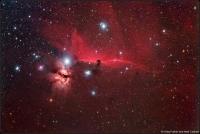Well, we are still in the depths of winter in January, so all the winter constellations are still very well-placed for imaging.
The Horsehead nebula (Barnard 33) in Orion is very well placed this month for imaging. The dark horse’s head is illuminated in front by several deep-sky objects:
- The massive emission nebula IC434
- The amazing flame nebula (NGC2024) to the horse’s left (North of the horse)
- A bright reflection nebula NGC2023 slightly South East of Alnitak
- And of course, Alnitak itself (the most eastern star in Orion’s belt) blazing away next to the flame nebula
With so much going on in this 2 degree by 1 degree region of space – no wonder this is probably the most highly photographed area of the night sky.
The 3.33 by 2.22 field of view of the Sky 90/M25C combination is ideal for this region, just centre the Horsehead on the crosshairs and start imaging. IC434 is actually very faint so the one-shot colour RGB subs need to be as long as you can manage at f#4.5. I use a minimum of 10-minute subs but 15-minutes is preferable. Of course, with magnitude 2 Alnitak blazing away in the scene, you will need to use very delicate processing to keep this star under control while bringing out the faint stuff – Noel excels at this sort of tough work 🙂
The whole region is rich in H-alpha emissions, so, if you can, you must include some H-alpha data with the RGB. I use my usual 20-minute sub-exposures for the H-alpha. Once again, you need to get as much of this data as you can reasonably acquire, and I would recommend in excess of 4 hours if you can manage it.
I have only recently acquired an SII and an OIII filter, so this accompanying wide field image of the Horsehead Nebula doesn’t have any OIII or SII data incorporated.
Getting this additional narrowband data is one of my priority jobs for January 2008.


